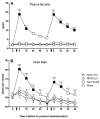A clinical laboratory model for evaluating the acute effects of electronic "cigarettes": nicotine delivery profile and cardiovascular and subjective effects
- PMID: 20647410
- PMCID: PMC2919621
- DOI: 10.1158/1055-9965.EPI-10-0288
A clinical laboratory model for evaluating the acute effects of electronic "cigarettes": nicotine delivery profile and cardiovascular and subjective effects
Abstract
Background: Electronic "cigarettes" are marketed to tobacco users as potential reduced exposure products (PREP), albeit with little information regarding electronic cigarette user toxicant exposure and effects. This information may be obtained by adapting clinical laboratory methods used to evaluate other PREPs for smokers.
Methods: Thirty-two smokers participated in four independent Latin-square ordered conditions that differed by product: own brand cigarette, "NPRO" electronic cigarettes (NPRO EC; 18 mg cartridge), "Hydro" electronic cigarettes (Hydro EC; 16 mg cartridge), or sham (unlit cigarette). Participants took 10 puffs at two separate times during each session. Plasma nicotine and carbon monoxide (CO) concentration, heart rate, and subjective effects were assessed.
Results: Own brand significantly increased plasma nicotine and CO concentration and heart rate within the first five minutes of administration whereas NPRO EC, Hydro EC, and sham smoking did not. Own brand, NPRO EC, and Hydro EC (but not sham) significantly decreased tobacco abstinence symptom ratings and increased product acceptability ratings. The magnitude of symptom suppression and increased acceptability was greater for own brand than for NPRO EC and Hydro EC.
Conclusions: Under these acute testing conditions, neither of the electronic cigarettes exposed users to measurable levels of nicotine or CO, although both suppressed nicotine/tobacco abstinence symptom ratings.
Impact: This study illustrates how clinical laboratory methods can be used to understand the acute effects of these and other PREPs for tobacco users. The results and methods reported here will likely be relevant to the evaluation and empirically based regulation of electronic cigarettes and similar products.
(c)2010 AACR.
Figures



References
-
- Pederson LL, Nelson DE. Literature review and summary of perceptions, attitudes, beliefs, and marketing of potentially reduced exposure products: communication implications. Nicotine Tob Res. 2007;9(5):525–534. - PubMed
-
- O’Connor RJ, Hyland A, Giovino GA, Fong GT, Cummings KM. Smoker awareness of and beliefs about supposedly less-harmful tobacco products. Am J Prev Med. 2005;29(2):85–90. - PubMed
Publication types
MeSH terms
Substances
Grants and funding
LinkOut - more resources
Full Text Sources
Other Literature Sources
Medical
Miscellaneous

